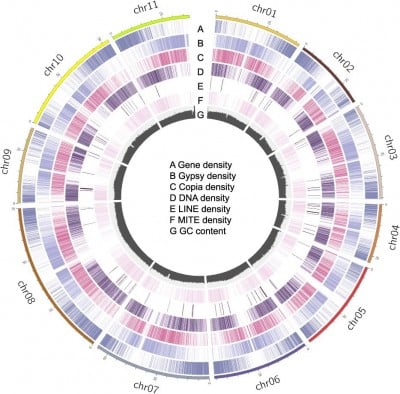Science
Researchers Unveil First Complete Mung Bean Genome for Breeding Insights

A team of researchers has successfully completed the first telomere-to-telomere (T2T) genome of the mung bean, scientifically known as Vigna radiata. This achievement marks a significant advancement in understanding the plant’s evolution and breeding potential. The study reveals how structural variations in the genome have played a crucial role in the domestication and adaptation of this important legume crop.
Using a combination of advanced sequencing technologies, including PacBio HiFi, Oxford Nanopore, and Hi-C sequencing, the researchers identified critical genetic changes linked to plant architecture, stress responses, and various metabolic pathways. These findings provide a comprehensive view of the mung bean’s genetic makeup, offering new insights into its capabilities and development.
Key Insights into Genetic Changes
The research uncovered that the amplification of transposable elements significantly influenced the expression of nearby genes. Notably, genes associated with fatty acid synthesis, suberin formation, and phenylpropanoid metabolism were found to have undergone strong selection pressures throughout the plant’s evolution. These genetic adaptations are essential for improving mung bean varieties, particularly in terms of yield and resilience to environmental stresses.
The implications of this research extend beyond academic curiosity. Understanding these genetic components can inform molecular breeding techniques, allowing scientists and agriculturalists to enhance mung bean crops to meet the growing global food demands.
Impact on Future Breeding Efforts
This gap-free genome serves as a valuable resource for researchers and breeders alike. With detailed insights into the genetic underpinnings of the mung bean, the study lays the groundwork for future explorations into how these plants can be optimized for better performance in various agricultural contexts. The findings highlight the importance of genomic research in addressing food security challenges, particularly in regions where mung beans are a staple food source.
As the world faces increasing pressures from climate change and population growth, the ability to improve crop resilience and yield through scientific advancements becomes increasingly vital. The completion of the T2T genome not only enhances our understanding of Vigna radiata but also opens doors for innovative breeding strategies that could significantly impact global agriculture.
This research underscores the intersection of science and agriculture, emphasizing the need for continued investment in genomic studies to support sustainable food production practices. The ongoing exploration of plant genomes promises to yield further insights that could revolutionize how we cultivate and utilize essential crops like the mung bean.
-

 Technology4 months ago
Technology4 months agoDiscover the Top 10 Calorie Counting Apps of 2025
-

 Health2 months ago
Health2 months agoBella Hadid Shares Health Update After Treatment for Lyme Disease
-

 Health3 months ago
Health3 months agoErin Bates Shares Recovery Update Following Sepsis Complications
-

 Technology3 weeks ago
Technology3 weeks agoDiscover 2025’s Top GPUs for Exceptional 4K Gaming Performance
-

 Technology4 months ago
Technology4 months agoDiscover How to Reverse Image Search Using ChatGPT Effortlessly
-

 Technology2 months ago
Technology2 months agoElectric Moto Influencer Surronster Arrested in Tijuana
-

 Technology4 months ago
Technology4 months agoMeta Initiates $60B AI Data Center Expansion, Starting in Ohio
-

 Technology4 months ago
Technology4 months agoRecovering a Suspended TikTok Account: A Step-by-Step Guide
-

 Health4 months ago
Health4 months agoTested: Rab Firewall Mountain Jacket Survives Harsh Conditions
-

 Lifestyle4 months ago
Lifestyle4 months agoBelton Family Reunites After Daughter Survives Hill Country Floods
-

 Technology3 months ago
Technology3 months agoUncovering the Top Five Most Challenging Motorcycles to Ride
-

 Technology4 weeks ago
Technology4 weeks agoDiscover the Best Wireless Earbuds for Every Lifestyle





















